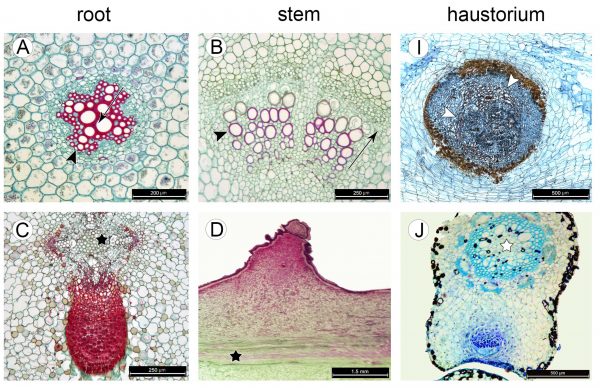Parasitic plants are highly diverse in terms of their evolutionary history, life cycles, growth habits, structure, etc. Even the haustorium, which “embodies the idea of plant parasitism”, varies widely among and within parasite groups. But if we look past conspicuous differences, what can we learn about haustorium structure and evolution? Is there a common pattern shared by different clades?
Well, it turns out there is! Based on a comparative analysis across the 12 lineages of parasitic plant, this paper recently published on the Brazilian Journal of Botany discusses a convergence in the topology of haustorium tissues and suggests a general body plan is common to the mature haustorium of all parasites.
In addition to examining multi-level convergence in haustorium structure across parasitic plant diversity, the paper provides a new answer for an age-old question: is the haustorium a modified root, a modified stem, or a one-of-a-kind type of organ? Considering the structure, molecular development, and functionality of this organ under the framework of continuum and process plant morphology, the paper proposes an interpretation of haustoria as “morphological misfits”.
Beyond offering a resolution to the conflict of haustorium homology and organ identity, this new interpretation opens up new research avenues for the comparison between parasitic plants and other morphological misfits, especially in terms of their evolutionary development. It also provides a more comprehensive framework for analyzing the haustorium across the multiple angiosperm lineages.
Teixeira-Costa. 2021. A living bridge between two enemies: haustorium structure and evolution across parasitic flowering plants. Brazilian Journal of Botany https://doi.org/10.1007/s40415-021-00704-0
